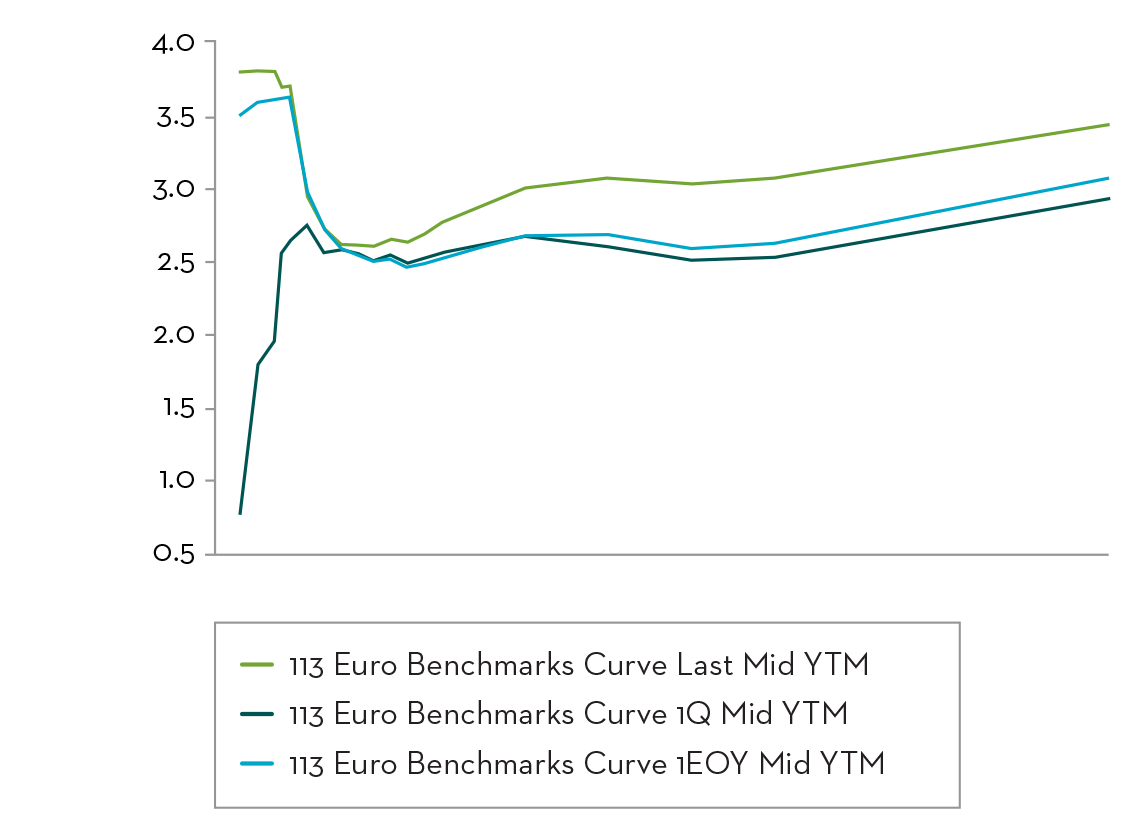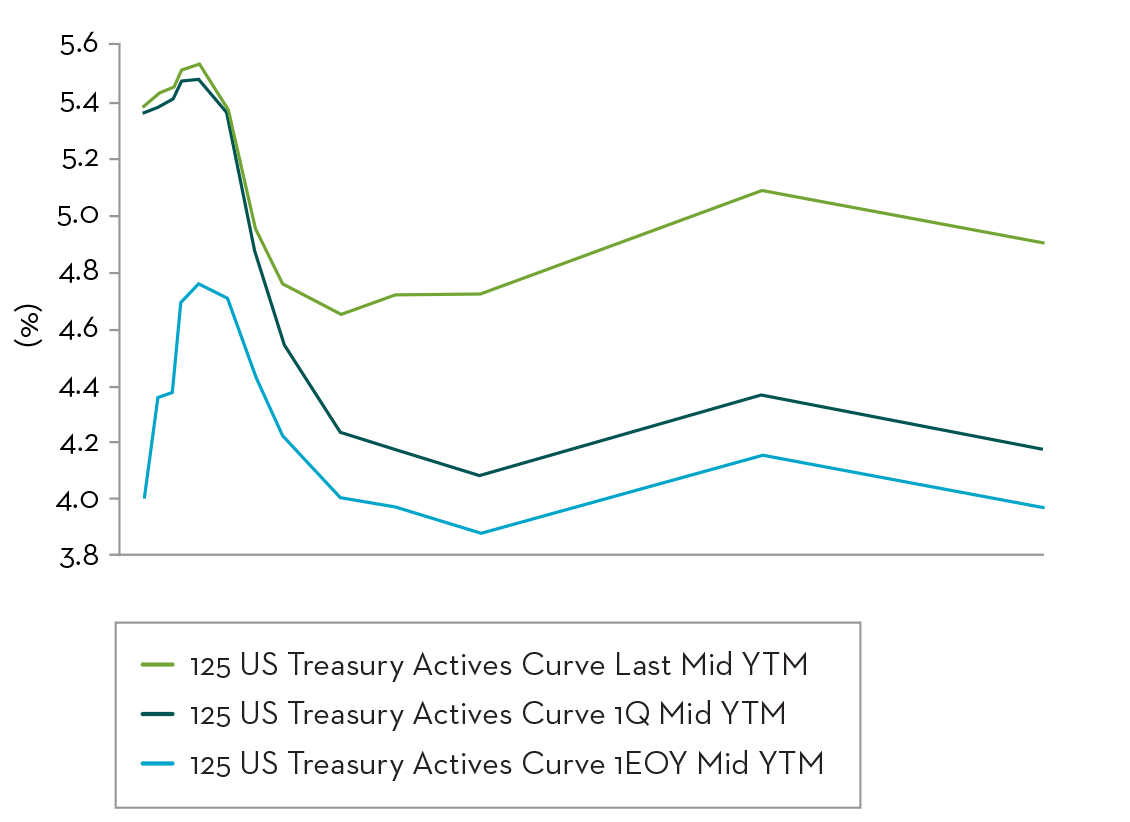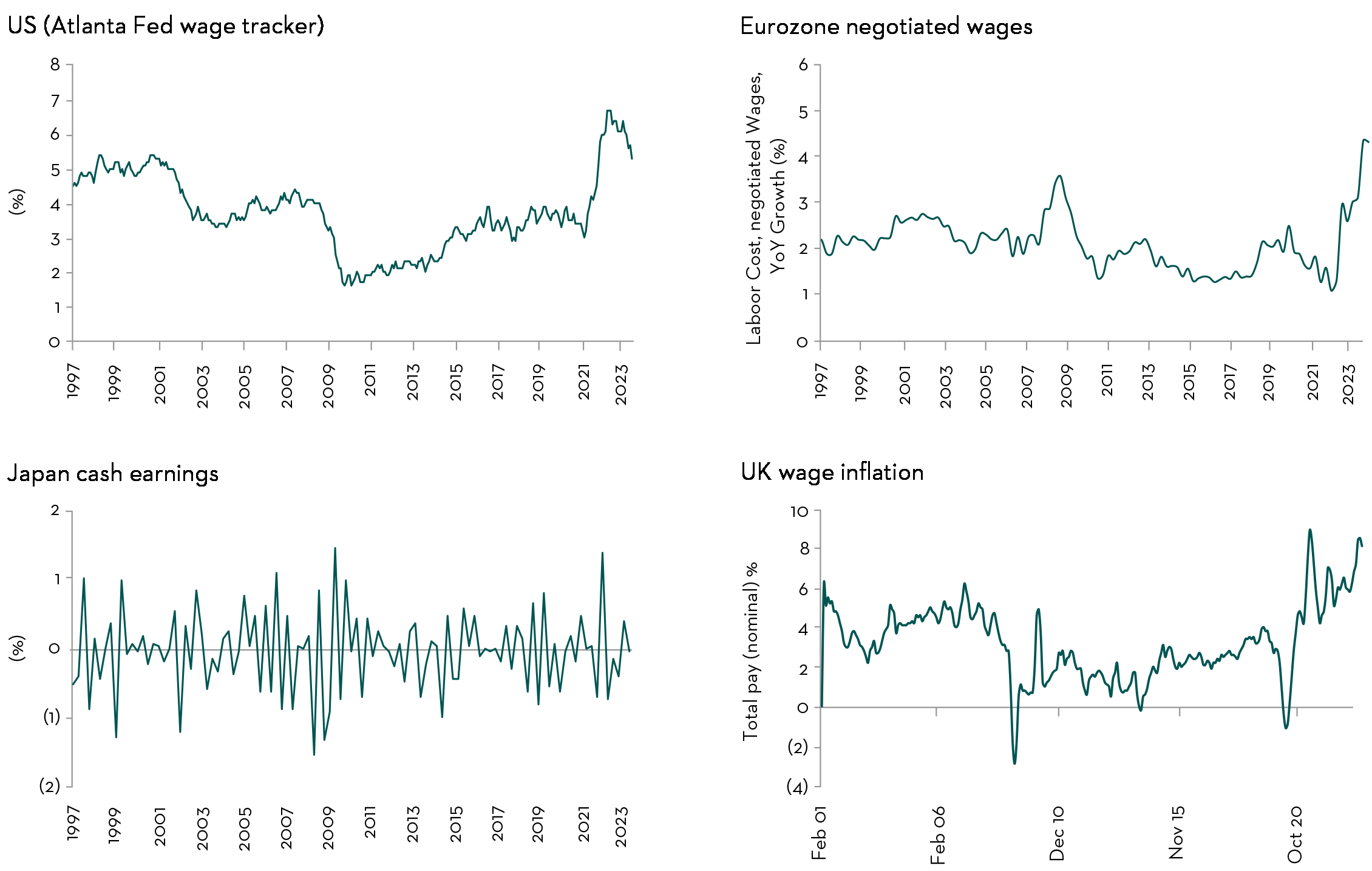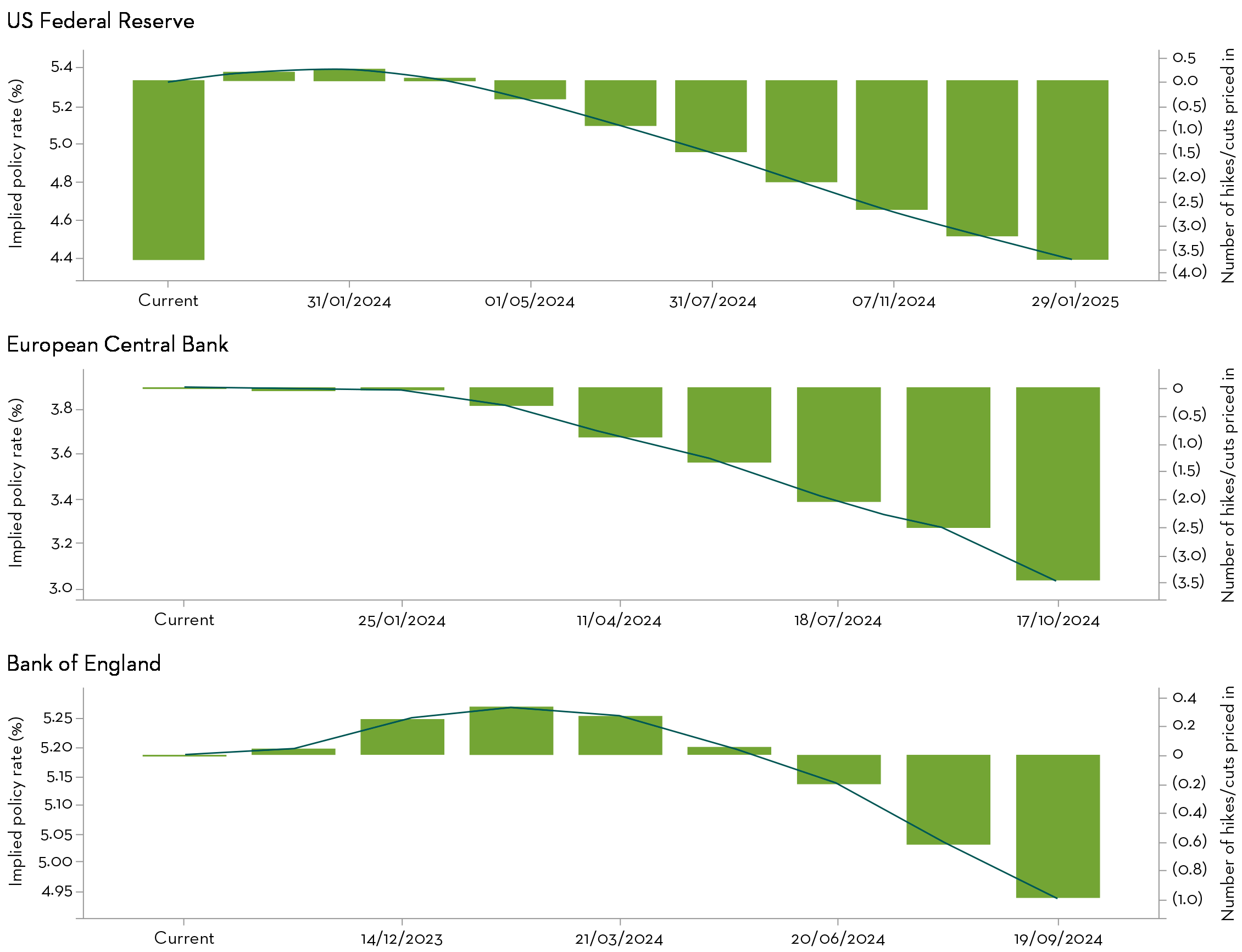Executive Summary
- The volatility in the bond and equity markets is a response to the hawkish stance demonstrated at the US Federal Reserve’s (Fed) September meeting and the European Central Bank’s latest rate hike.
- The peak in rates is nearing, but a pivot is unlikely before H2 2024. The market is now shifting its stance towards our assumptions on later rate cuts. Given the inflationary backdrop it is relevant for investors to continue to focus on companies with pricing power.
- Stickier inflation was a surprise to the market, but in line with our predictions. With interest rates set to remain higher for longer, this is leading to a so-called bear steepening in yield curves. These higher rates are highlighting the importance of valuation discipline for investors.
A more hawkish US Federal Reserve (Fed) combined with the European Central Bank (ECB) September’s rate hike rate have led to an increased volatility across bond and equity markets alike. Despite this, following the Fed’s Open Market Committee (FOMC) meeting, the market reacted in a sanguine manner to the realisation that interest rates might stay higher for longer.
A more hawkish Fed and ECB is a reflection of a stickier inflation outlook
Although holding back from raising rates in September, the hawkish aspects of both the Fed’s meeting and Jerome Powell (the Fed Chair) subsequent press interview surprised the market.
This has led to exceptionally elevated volatility in both bond markets and equity markets. Long-term rates have moved towards the c.5% level for the 10 years, 20 years and 30 years maturities, with the yield curve experiencing a so-called “bear-steepening”.
In our view, in itself the bear steepening a potential worry for the economic growth outlook. The magnitude of the move in the yield curve for both the US and Euro areas can be seen in the chart below.
Yield curves as at 31 December 2022, 2 August 2023 and 2 November 2023
European Central Bank

US Federal Reserve

Source: Bloomberg Finance L.P, 1 November 2023.
-
A more hawkish US Federal Reserve (Fed) combined with the European Central Bank (ECB) September’s rate hike rate have led to an increased volatility across bond and equity markets alike.
Central banks shifting to firefighting persistent inflation
We believe the Fed’s inflation projection was a particular surprise for the market.
Extended to include 2026, the Fed raised the inflation forecast to 2.2% for 2025 (from 2.1%), adding that an inflation rate of c.2% is not going to be reached before 2026. The latter point was of particular focus to the market, as it could be seen as the Fed admitting that inflation will be more persistent than expected.
The particularly hawkish implication of this projection is the suggestion that Fed’s primary target will be reducing inflation than stimulating economic growth.
Whilst we are cognisant that this focus can rapidly shift. If market conditions evolve to such an extent that economic growth is at risk, it could mean that the Fed could be tolerant of an extended period of low, or even no economic growth.
In other words, the “cavalry-to-the-rescue” role that central banks used to fulfil seems to have changed to a “firefighting persistent inflation fires” mode; a regime shift in monetary policies.
The FOMC meeting also highlighted that the Fed has reduced the number of planned rate cuts in 2024, and that rates are projected to end in 2024 at a level above the neutral rate.
Data dependency remains the modus operandi for central banks at this stage in the cycle, so inflation prints and any data relevant to inflation forecasting will be important to watch. This shift to data dependency by central banks will lead to additional volatility in markets. We detailed this in last month’s update ‘Jackson’s Five’, our review of the Jackson Hole Symposium.
| Variable | 2023 | 2024 | 2025 | 2026 | Longer run | 2023 | 2024 | 2025 | 2026 | Longer run |
|---|---|---|---|---|---|---|---|---|---|---|
| Change in real GDP | 2.1 | 1.5 | 1.8 | 1.8 | 1.8 | 1.8–2.6 | 0.4–2.5 | 1.4–2.5 | 1.6–2.5 | 1.6–2.5 |
| June projection | 1.0 | 1.1 | 1.8 | 1.8 | 0.5–2.0 | 0.5–2.2 | 1.5–2.2 | 1.6–2.5 | ||
| Unemployment rate | 3.8 | 4.1 | 4.1 | 4.0 | 4.0 | 3.7–4.0 | 3.7–4.5 | 3.7–4.7 | 3.7–4.5 | 3.5–4.3 |
| June projection | 4.1 | 4.5 | 4.5 | 4.0 | 3.9–4.5 | 4.0–5.0 | 3.8–4.9 | 3.5–4.4 | ||
| PCE inflation | 3.3 | 2.5 | 2.2 | 2.0 | 2.0 | 3.1–3.8 | 2.1–3.5 | 2.0–2.9 | 2.0–2.7 | 2.0 |
| June projection | 3.2 | 2.5 | 2.1 | 2.0 | 2.9–4.1 | 2.1–3.5 | 2.0–3.0 | 2.0 | ||
| Core PCE inflation* | 3.7 | 2.6 | 2.3 | 2.0 | 3.5–4.2 | 2.3–3.6 | 2.0–3.0 | 2.0–2.9 | ||
| June projection | 3.9 | 2.6 | 2.2 | 3.6–4.5 | 2.2–3.6 | 2.0–3.0 | ||||
| Federal funds rate | 5.6 | 5.1 | 3.9 | 2.9 | 2.5 | 5.4–5.6 | 4.4–6.1 | 2.6–5.6 | 2.4–4.9 | 2.4–3.8 |
| June projection | 5.6 | 4.6 | 3.4 | 2.5 | 5.1–6.1 | 3.6–5.9 | 2.4–5.6 | 2.4–3.6 |
Source: US Federal Reserve, October 2023. *Note: Projections of change in real gross domestic product (GDP) and projections for both measures of inflation are percent.
Stickier inflation highlights the importance of focusing on companies with pricing power
This sticky inflation is in line with our own view that inflation would be more elevated and longer lasting. This was detailed in both our 2023 outlook (published December 2022) and our mid-year update from July 2023.
We expressed the view that the 2% inflation target would not be reached in 2024 by neither the Fed nor the ECB. Although that both central banks would come closer to that target by then. Our view is that the 2% target will be reached during 2025 – a year earlier than updated Fed projection.
Our view is that the 2% target will be reached in the course of 2025, which is one year sooner than the recent Fed projection.
Persistent inflation, we believe is a reflection of pressure from wage inflation. This is bringing the risk of a new round of inflationary pressure. Again, we highlighted this in October 2022 (All eyes on wage inflation), that this would be the biggest determinant of medium-term inflation.
As shown in the charts below, wage inflation has been picking up across many regions, even Japan, albeit to a lesser extent. It has increased the risk of inflation turning from frictional to structural and therefore longer lasting.
Wage inflation

Source: Martin Currie and FactSet as at 30 June 2023.
Markets are shifting expectations on when central banks will pivot
The more hawkish stance from the US and European central banks has led the market to shift its expectations on when central banks will pivot. We remain of the view that we are now getting very close to peak in interest rates.
We are continuing to predict a maximum of two further hikes for both the Fed and the ECB, with rates peaking by the end of this year.
We also continue to forecast a slow shift towards a pivot in monetary policies, which we do not expect before H2 2024. The market has now shifted its expectations towards a similar stance, as can be seen from the consensus interest rate probabilities captured in the charts below.
Central Banks market-implied policy rates projections

Source: Bloomberg Finance L.P, 1 November 2023.
Higher rates for longer emphasises the importance of valuation discipline
The bear-steepening in the yield curve, highlights the importance for investors to maintain valuation discipline in all phases of the economic cycle. But even more so in this phase of the cycle, when economic uncertainties abound.
Using our long-term valuation tools, we have been anticipating normalising interest rate policies even when rates were at zero or close to zero, some 18-24 months ago. This is important to do in our view, as long-term valuation tools should be both forward looking, and anticipate normalisation. As a result, we had been using a long-term interest rate assumption of 4% until last September 2022, when we increased that assumption to 5%.
The step increase was based on the assumption that inflation would be more elevated and longer lasting. We shifted our long-term inflation rate assumption up from 2% to 3%, which led to the increase in long term interest rate assumption from 4% to 5%.
In light of the long-term interest rates hovering around the 5% mark, we believe that the market has now come to discount that more elevated inflation rate assumption more accurately.
In next month’s market insights, we will detail our disciplined valuation approach, and the reasoning for using a 5% long term interest rate assumption.
Important Information
This information is issued and approved by Martin Currie Investment Management Limited (‘MCIM’), authorised and regulated by the Financial Conduct Authority. It does not constitute investment advice. Market and currency movements may cause the capital value of shares, and the income from them, to fall as well as rise and you may get back less than you invested.
The information contained in this document has been compiled with considerable care to ensure its accuracy. However, no representation or warranty, express or implied, is made to its accuracy or completeness. Martin Currie has procured any research or analysis contained in this document for its own use. It is provided to you only incidentally and any opinions expressed are subject to change without notice.
The document does not form the basis of, nor should it be relied upon in connection with, any subsequent contract or agreement. It does not constitute, and may not be used for the purpose of, an offer or invitation to subscribe for or otherwise acquire shares in any of the products mentioned.
Past performance is not a guide to future returns.
The distribution of specific products is restricted in certain jurisdictions, investors should be aware of these restrictions before requesting further specific information.
The views expressed are opinions of the portfolio managers as of the date of this document and are subject to change based on market and other conditions and may differ from other portfolio managers or of the firm as a whole. These opinions are not intended to be a forecast of future events, research, a guarantee of future results or investment advice.
Risk warnings – Investors should also be aware of the following risk factors which may be applicable to the strategy shown in this document.
- Investing in foreign markets introduces a risk where adverse movements in currency exchange rates could result in a decrease in the value of your investment.
- This strategy may hold a limited number of investments. If one of these investments falls in value this can have a greater impact on the strategy’s value than if it held a larger number of investments.
- Smaller companies may be riskier and their shares may be less liquid than larger companies, meaning that their share price may be more volatile.
- Emerging markets or less developed countries may face more political, economic or structural challenges than developed countries. Accordingly, investment in emerging markets is generally characterised by higher levels of risk than investment in fully developed markets.
- The strategy may invest in derivatives Index futures and FX forwards to obtain, increase or reduce exposure to underlying assets. The use of derivatives may result in greater fluctuations of returns due to the value of the derivative not moving in line with the underlying asset. Certain types of derivatives can be difficult to purchase or sell in certain market conditions.
For wholesale investors in Australia:
This material is provided on the basis that you are a wholesale client within the definition of ASIC Class Order 03/1099. MCIM is authorised and regulated by the FCA under UK laws, which differ from Australian laws.
For professional investors in Canada.
This material is intended for residents in, or incorporated in, Canada and are a Permitted Client for the purposes of MI 31-103. The information on this section of the website is not intended for use by any other person, including members of the public.
Martin Currie Inc, incorporated in New York with its registered office at 280 Park Avenue, New York, NY 10017 and having a UK branch registered in Scotland (no SF000300), Head office, 5 Morrison Street, 2nd floor, Edinburgh, EH3 8BH, Tel: +44 (0) 131 229 5252 Fax: +44 (0) 131 222 2532 www.martincurrie.com, operates under the International Adviser Exemption with the Ontario Securities Commission (‘OSC’) and is therefore currently not required to be registered as a portfolio manager for the purposes of MI 31-103. Martin Currie Inc. is also authorised by the UK Financial Conduct Authority.
For the avoidance of doubt, nothing excludes, limits or restricts our obligations to you under the UK Financial Services and Market Act 2000, National Instruments or any other applicable law or regulation.
The opinions and views in this website do not take into account your individual circumstances, objectives, or needs and are not intended to be recommendations of particular financial instruments or strategies to you.
This website does not identify all the risks (direct or indirect) or other considerations which might be material to you when entering any financial transaction. You should consult with your professional advisers before undertaking any investment activity. The information provided on this website should not be treated as advice or a recommendation to buy or sell any particular security or other investment. The information on this website has not been reviewed by any competent regulatory authority.
For professional investors:
In the People’s Republic of China:
This document does not constitute a public offer of the strategy, whether by sale or subscription, in the People’s Republic of China (the “PRC”). These strategies are not being offered or sold directly or indirectly in the PRC to or for the benefit of, legal or natural persons of the PRC.
Further, no legal or natural persons of the PRC may directly or indirectly purchase any of the strategy or any beneficial interest therein without obtaining all prior PRC’s governmental approvals that are required, whether statutorily or otherwise. Persons who come into possession of this document are required by the issuer and its representatives to observe these restrictions.
In Hong Kong:
The contents of this document have not been reviewed by any regulatory authority in Hong Kong. You are advised to exercise caution in relation to the offer. If you are in any doubt about any of the contents of this document, you should obtain independent professional advice.
In South Korea:
This document is for information purposes only. It is prepared and presented to provide an introduction to the business of MCIM and its related companies (collectively known as ‘Martin Currie’). This document does not constitute an offer to sell or a solicitation of any offer to invest in any security, fund or other vehicle managed or advised by Martin Currie.
None of the security(ies), fund(s) or vehicle(s) managed by or advised by Martin Currie are registered in South Korea under the Financial Investment Services and Capital Markets Act of Korea and accordingly, none of these instruments nor any interest therein may be offered, sold or delivered, or offered or sold to any person for re-offering or resale, directly or indirectly, in South Korea or to any resident of South Korea except pursuant to applicable laws and regulations of South Korea.
Martin Currie is not registered with or regulated by any regulatory authorities in South Korea.


